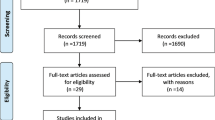Abstract
Background
Prosthetic mesh reinforcement is standard practice for inguinal hernia repair but can cause considerable pain and stiffness around the groin and affect physical functioning. This has led to various types of mesh being engineered, with a growing interest in a lighter weight mesh. The aim of this prospective study was to compare the outcome after laparoscopic totally extra-peritoneal (TEP) inguinal repair using new lightweight or traditional heavyweight mesh performed in a single specialist centre.
Methods
Between November 2004 and July 2005, 250 patients underwent laparoscopic TEP inguinal repair using either lightweight (Ultrapro®, 30 g/m2) or heavyweight (Prolene®, 100 g/m2) mesh. Follow-up data was obtained using case note review and telephone-based questionnaire. Patients were followed up within the early and late post-operative periods to assess any changes in outcome.
Results
Follow-up information was obtained for 188 (75%) out of 250 patients. There was no difference between lightweight and heavyweight groups in the incidence or severity of pain/discomfort at mean 4 and 15 months follow-up. There was significantly less interference with physical activity at short and long term follow-up in the lightweight group, in particular lifting (9% vs 21% at mean 4 months, Mann–Whitney U, P = 0.024), walking (1% vs 11% at mean 15 months, Mann–Whitney U, P = 0.006) and vigorous activities (7% vs 19% at mean 15 months, Mann–Whitney-U, P = 0.012). There was no significant difference in awareness of mesh or stiffness in the groin.
Conclusions
Laparoscopic TEP inguinal hernia repair with a lightweight mesh improves functional outcome in the short and long term. There was significantly less interference with all aspects of physical activity with the lightweight mesh. Pain in both groups was very mild, highlighting the benefits of laparoscopic surgery.

Similar content being viewed by others
References
Hair A, Duffy K, McLean J et al (2000) Groin hernia repair in Scotland. Br J Surg 87:1722–1726
Kingsnorth A, LeBlanc K (2003) Hernias: inguinal and incisional. Lancet 362(9395):1561–1571
National Institute for Clinical Excellence (2004) Guidance on the use of laparoscopic surgery for inguinal hernia. Technological appraisal guidance no. 83. NICE, London
MRC Laparoscopic Groin Hernia Trial Group (1999) Laparoscopic versus open repair of groin hernia: a randomised comparison. Lancet 354:185–190
EU Hernia Trialist Collaboration (2002) Laparoscopic versus open groin hernia repair: meta-analysis of randomised trials based on individual patient data. Hernia 6:2–10
Cobb WS, Kercher KW, Heniford BT (2005) The argument for lightweight polypropylene mesh in hernia repair. Surg Innov 12:63–69
Junge K, Rosch R, Krones CJ, Klinge U, Mertens PR, Lynen P, Schumpelick V, Klosterhalfen B (2005) Influence of polyglecaprone 25 (Monocryl) supplementation on the biocompatibility of a polypropylene mesh for hernia repair. Hernia 9:212–217
Khan LR, Kumar S, Nixon SJ (2006) Early results for new lightweight mesh in laparoscopic totally extra-peritoneal inguinal hernia repair. Hernia 10:303–308
Post S, Weiss B, Willer M, Neufang T, Lorenz D (2004) Randomized clinical trial of lightweight composite mesh for lichtenstein inguinal hernia repair. Br J Surg 91:44–48
O’Dwyer PJ, Kingsnorth AN, Molloy RG, Small PK, Lammers B, Horeyseck G (2005) Randomized clinical trial assessing impact of a lightweight or heavyweight mesh on chronic pain after inguinal hernia repair. Br J Surg 92:166–170
Champault G, Barrat C (2005) Inguinal hernia repair with beta glucan-coated mesh: results at two-year follow up. Hernia 9:125–130
Bringman S, Wollert S, Osterberg J, Heikkinen T (2005) Early results of a randomized multicenter trial comparing Prolene and VyproII mesh in bilateral endoscopic extraperitoneal hernioplast (TEP). Surg Endosc 19:536–540
Nixon SJ, Kumar S (2005) The totally extraperitoneal approach (TEP) to inguinal hernia repair. Surgeon 3:281–7, 305
Ware JE Jr, Sherbourne CD (1992) The MOS 36-item-short-form health survey (SF36). 1. Conceptual framework and item selection. Med Care 30:473–483
Kurzer M, Kark AE, Hussain T (2008) Hernia repair: outcomes other than recurrence should be analysed. BMJ 336:1033
Koch A, Bringman S, Myrelid P, Smeds S, Kald A (2008) Randomized clinical trial of groin hernia repair with titanium-coated lightweight mesh compared with standard polypropylene mesh. Br J Surg 95:1226–1231
Agarwal BB, Agarwal KA, Mahajan KC (2009) Prospective double-blind randomized controlled study comparing heavy- and lightweight polypropylene mesh in totally extraperitoneal repair of inguinal hernia: early results. Surg Endosc 23: 242–247
Heikkinen T, Wollert S, Osterberg J, Smedberg S, Bringman S (2006) Early results of a randomised trial comparing Prolene and VyproII-mesh in endoscopic extraperitoneal inguinal hernia repair (TEP) of recurrent unilateral hernias. Hernia 10:34–40
Kumar S, Wilson RG, Nixon SJ, Macintyre IMC (2002) Chronic pain after laparoscopic and open mesh repair of groin hernia. Br J Surg 89:1476–1479
Courtney CA, Duffy K, Serpell MG, O’Dwyer PJ (2002) Outcome of patients with severe chronic pain following repair of groin hernia. Br J Surg 89:1310–1314
Langenbach MR, Schmidt J, Ubrig B, Zirngibl H (2008) Sixty-month follow-up after endoscopic inguinal hernia repair with three types of mesh: a prospective randomized trial. Surg Endosc 22:1790–1797
Bringman S, Wollert S, Osterberg J, Smedberg S, Granlund H, Heikkinen TJ (2006) Three-year results of a randomized clinical trial of lightweight or standard polypropylene mesh in lichtenstein repair of primary inguinal hernia. Br J Surg 93:1056–1059
Grant AM, Scott NW (2004) MRC laparoscopic groin hernia trial group. Five-year follow-up of a randomized trial to assess pain and numbness after laparoscopic or open repair of groin hernia. Br J Surg 91:1570–1574
Champault G, Bernard C, Rizk N, Polliand C (2007) Inguinal hernia repair: the choice of prosthesis outweighs that of technique. Hernia 11:125–128
Beattie GC, Kumar S, Nixon SJ (2000) Laparoscopic total extraperitoneal hernia repair: mesh fixation is unnecessary. J Laparoendosc Adv Surg Tech A 10:71–73
Author information
Authors and Affiliations
Corresponding author
Rights and permissions
About this article
Cite this article
Khan, L.R., Liong, S., de Beaux, A.C. et al. Lightweight mesh improves functional outcome in laparoscopic totally extra-peritoneal inguinal hernia repair. Hernia 14, 39–45 (2010). https://doi.org/10.1007/s10029-009-0558-2
Received:
Accepted:
Published:
Issue Date:
DOI: https://doi.org/10.1007/s10029-009-0558-2




